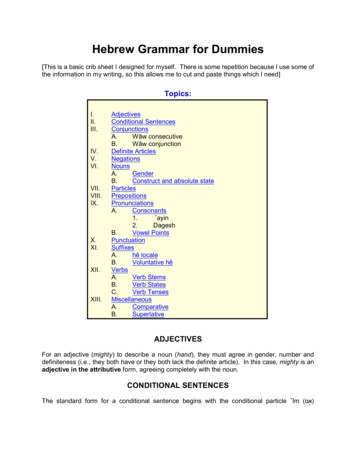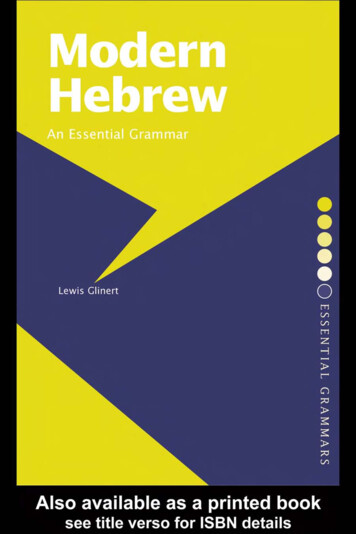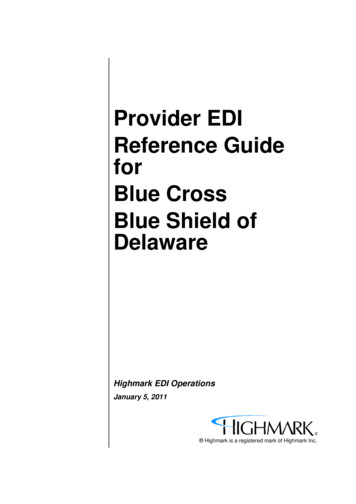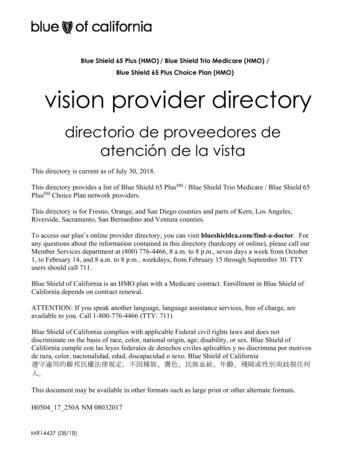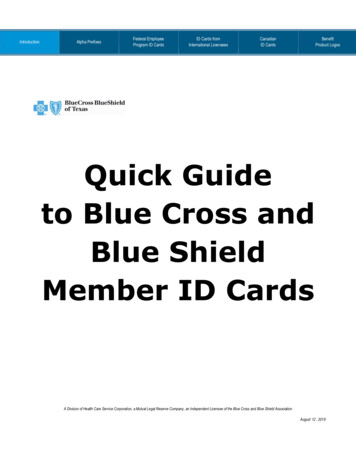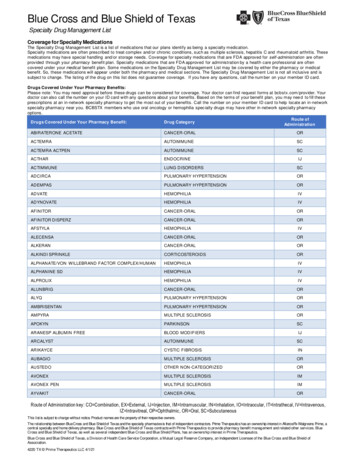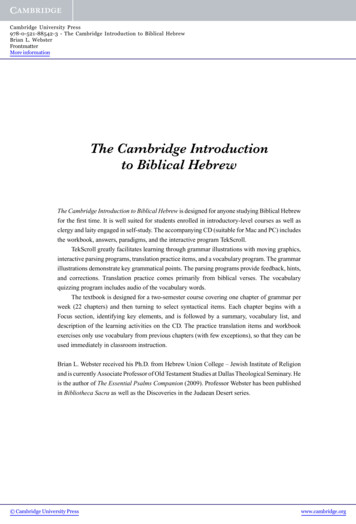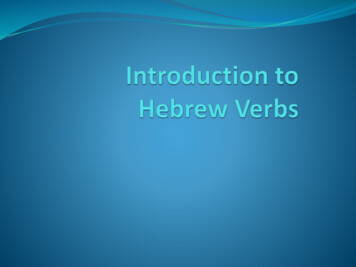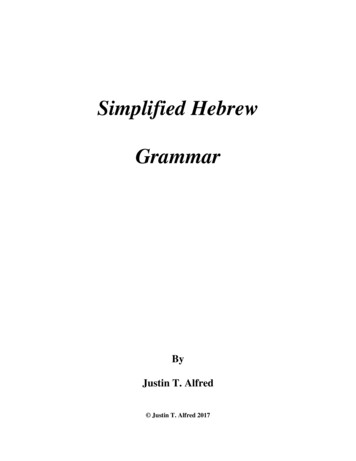
Transcription
Simplified HebrewGrammarByJustin T. Alfred Justin T. Alfred 2017
Table of ContentsIntroduction1-3Section One3-6Alphabet3-4Cursive Writing4-6Section Two7-27Word Formation7Vowel Signs8Letters & VowelsSewaGender & Number In Hebrew Nouns, Pronouns,Adjectives, Verbs, & Participles8-232425-26The Definite Article26The Conjunction27The Inseparable Prepositions27Section Three28-42Verb Tenses24Perfect Tense29-34Imperfect ves, Cohortatives, Emphatic Imperatives,Jussives, & Negative Prohibitions42
Section Four42-44Use of Interlinear, Analytical& Hebrew-English Lexicon42-44Section Five45-47Practical Exegesis45-47Conclusion48-50
Simplified Hebrew Grammar IntroductionThis course is designed to give busy pastors and lay people who want to learn thebiblical languages an opportunity to do so without being overwhelmed with the rigors ofhaving to learn the entire grammars of Greek and Hebrew. Most people, therefore, simplywant to have a working knowledge of the biblical languages rather than trying to be ascholar in order to attain such knowledge.Thus, after having taught the biblical languages courses for ten years at FullerTheological Seminary's Extension School in Colorado Springs, Colorado, the Lord beganto impress upon me through a series of events that there was a great need in the body ofChrist that wasn't being met; that is, the need to make the acquisition of a workingknowledge of Greek and Hebrew available to the masses who want such knowledge, butwho do not have the time, giftedness, nor finances to spend on learning the minutiae ofthe grammars of each language.During my years of teaching, I noticed that my Greek courses would usually haveabout a 50% attrition rate, and the Hebrew courses would average around 75%. I knowthat when I was in seminary there would always be people who would drop the languagecourses. Many of those who did so would go for degrees that didn't require any languageproficiency, or they would pursue degrees that required a bare minimum simply for thesake of stating on one's transcript that they had taken Greek and Hebrew. However, suchcourses as the latter didn't really give the student anything as far as an ability topractically use the language; in fact, most of the students who took such courses forgotwhat little they learned soon after graduating! Thus, the idea behind requiring students totake the biblical languages was circumvented for the sake of merely getting a degree.That in turn brings into question the real purpose and motivation for a seminary educationwhich is SUPPOSED TO BE FOR THE TRAINING AND EQUIPPING OF MEN ANDWOMEN FOR THE WORK OF THE MINISTRY!Consequently, this course will require that the student read, study, andmemorize; there is NO COURSE DESIGNED THAT CAN DO THOSETHINGS FOR A STUDENT, NOR THAT CAN CIRCUMVENT THE WORKTHAT IS NECESSARY FOR ONE TO TRULY LEARN! Nonetheless, thiscourse is designed to help facilitate someone receiving a good, solid, accurate,1
working knowledge of Greek and Hebrew without spending the traditional twoyears of intense grammatical study that is the minimum time necessary to gaina beginning level of understanding for a more scholarly pursuit of thelanguages.Approach To This StudyThe first section of this course will be aimed at learning the Hebrew lettersthemselves, their pronunciation, the English equivalent, and how to write theHebrew letters in cursive form.The second section will be to put the Hebrew letters and the vowel signstogether to form words and learn to pronounce them correctly (e.g.,rb'D'–dābār word – Hebrew is read for right to left). This will be an exciting stageas you actually begin to recognize the Hebrew letters and vowel signs andtheir proper pronunciation when placed together to form words.The third section will be learning the various verb tenses, voices, andmoods and just what they mean. This probably will be the most exciting, aswell as the hardest, in that you will have to begin to change your thoughtpattern from an English speaker and thinker to a Hebrew speaker and thinker.The fourth section will be the light at the end of the tunnel as you begin tolearn how to go from the Interlinear Hebrew-English Old Testament, toDavidson’s Analytical Hebrew and Chaldee Lexicon, and then to Gesenius’Hebrew-Chaldee Lexicon to the Old Testament in discovering not only thedefinition of a word, but also how to understand its usage and application in aparticular passage. To know the definition of a Hebrew word is important andbeneficial, but to know how it is used and to be interpreted in a passage is thereal key to using and understanding Hebrew, and that is what you will learn todo!The fifth and final section will be the practical exegesis of various passages in theHebrew Old Testament. In this section you will have repeated opportunity to researchand investigate passages of interest to you. You may in turn write an exegesis paperthat can be in the form of a sermon message, a Bible study, or a paper or booklet in2
which you are writing on a topic to be disseminated for either evangelistic purposes, orfor ministry to the body as a whole; the choice will be yours.Section OneThe Hebrew AlphabetFormNameTransliterationa ׳ Alep’b, b (bh/v)g, g (gh)d, d (dh)hw/vzµ (ch-German)‰yk, k, (ch-")lmns‘p, p, (ph-Phil)ƒ (pits)qr , š (sh-shut)t, t (th-thump) , , , , , * , , , , * , * , , Samek‘AyinPeSadeQopResSin, ShinTawYou will notice in the Hebrew alphabet that there are five letters with anasterisk (*) beside them ( , , * [k]; , [m]; , [n]; , , * [p]; , * [ƒ]),and the asterisk is indicating the five, final forms of those letters; i.e., this ishow that letter will appear when it is the final letter of a word. Otherwise, itwill appear as the initial form when it is at the beginning or middle of a word(e.g., then[n] inaybin" [nābi’] is at the beginning of the word, but in !aco3
[̣ s ̣ ō ’n],n [n] is the final letter of the word and takes the final form, ! [n], andthis will be the case with the other four letters that also have a final form). Inaddition, you will also notice that there are six letters that have a form with adot in the middle of the word, as well as a form without the dot. Those lettersare: , (b); , (g); , (d); , , (k); , , (p); , (t). The letter with the dotin the middle is called a non-spirantized letter, and the letter without the dot is called aspirantized letter. The dot itself is called a daghesh lene, and we will discuss this furtherbelow, but suffice it to say that all of these forms, dots, etc., are important for you toknow in learning the proper pronunciation of the letters.Cursive WritingIn the following exercise, I want you to begin practicing writing theHebrew letters in cursive script; i.e., the script you will use in your ownhandwriting. The Hebrew cursive will be similar to the printed form, but itwill also differ in the same way as English print differs from our cursivehandwriting in English. After you write each Hebrew letter, I then want youto transliterate that letter into English (e.g., -’; -b; -g; etc.), and Iwant you to do this all the way across the line. In addition, I have given youboth the non-spirantized and spirantized form of six Hebrew letters mentionedabove that have the dot (i.e., the daghesh lene). And again, as stated above,the non-spirantized form is the form with the dot in the letter, and thespirantized form does not have the dot. Therefore, I want you to transliteratethose letters in the following manner: -b; -b(v); -g; -g(gh); -d; -d(dh); -k; -k;(ch); (when this is the final letter in aword, it is written with these two dots in it, and it is pronounced as a spirant ch); -p; -p(ph); -t; -t(th). As you will note, thespirantized, transliterated forms of these letters (i.e., the ones without thedots) have an English letter with a line under it (e.g., -t), and that is theway you write that letter when you are transliterating from Hebrew into4
English, and then beside that English letter with the line under it, you willfind an English, phonetical pronunciation of that letter, as with t(th). The“th” is the way the t is actually pronounced in English. For example, inHebrew, the word for house is ( ַבּיִ ת bayit), I wrote the spirantized form of in English as “t,” and the English, phonetic pronunciation of “t” is “th.” Inthe exercise below, write the formal English transliterated form, and then inparenthesis, write the phonetic pronunciation of that letter, as with -t(th). (’) 5
(‘) 6
Section TwoWord FormationHebrew, unlike Greek, has no letters that remotely compare to any English letters.Thus, it is a bit more difficult at first to associate the letters with the correct sound inword formations. In addition, unlike Greek as well, Hebrew does not have any vowelletters (except for , and which help to form vowel sounds with certain vowelmarks). Thus, from about the beginning of the seventh century AD toward the end of thetenth century AD, a major effort was undertaken to produce what is today called theMasoretic Text of the Hebrew Bible as the following quote explains:Masoretic (maz-uh-ret ik) Text, the standard or traditional Hebrew text of theBible, as preserved by the Masoretes, a group of rabbinic scholars active ca. 600–950 CE. There is, however, more than one version of the Masoretic Text. First,there were three major groups of Masoretes: Palestinian, Babylonian, andTiberian. Of these, Tiberian Masoretes gained prominence, so the Tiberianversion of the Hebrew Bible is usually associated with what is called theMasoretic Text today. Beyond this, however, the Tiberian Masoretes differed onminor matters and produced a number of slightly different texts. Those producedby the family of Aaron ben Asher came to be regarded as the best, and these arepreserved today in two frequently consulted manuscripts: the Aleppo Codex andthe Leningrad Codex. Both of these contain, not only the text of the Bible writtenout in Hebrew consonants, but also vowels and accent signs determined to beappropriate by the Masoretes. Further, both the Aleppo Codex and the LeningradCodex contain numerous Masorah, numbers and abbreviations that occur as notesin the margins and other key points in the text. The Masoretic Text of the Bible(as preserved especially in the Leningrad Codex) forms the primary basis formost English Bible translations, including the NRSV, although manuscripts of theLXX are also consulted and sometimes given preference when the readingpreserved there is believed to represent a more ancient tradition.1As stated above, this laborious task was completed in the tenth century, and we are stillusing it today! Therefore, not only do you have to learn the proper phonetic sound of theletters, but you also have to learn the proper pronunciation of those letters combined withthe various vowel signs. However, as you memorize and practice both the phoneticpronunciation of the Hebrew letters, as well as the vowel signs and their correspondingsounds that were placed within, underneath, and around the Hebrew letters by theMasoretes, you will in turn be able to pronunce the Hebrew of the Masoretic text.1Bruce M. Metzger, “Masoretic Text,” in The Harper Collins Bible Dictionary (revised & updated), 2011.7
Vowel SignsThere are five short and seven long Hebrew vowels:Short ;a BuLong * Qames - ā as in fātherPathah - a as in badSeghol - e as in led Hireq - i as in hid Sere-yod - ê as in obêyQibbus - u as in pull Hireq-yod - î as in Kristîne - Sureq - û as in frûit* Qames-Hatuph - o as in most Sere - ē as in obēy- Full-Holem - ô as in tôe- Defective-Holem - ō in tōe* These two signs are pronounced differently under certain, grammatical conditions.However, for our purposes at this point, you will only be given the long “father” form ofpronunciation.Letters & VowelsWe will now begin to put the vowel signs together with the letters to form words. Thiswill be both challenging and fun as you begin to form actual Hebrew words andpronounce them. However, you must put forth the proper effort in order to do thiscorrectly, or else you will have considerable trouble from this ;point forward; in otherwords, this is a foundational step, which if you don't master, you will be very frustratedand ineffective in your attempt to accurately and adequately use this material.In Exercise One, I have written the Hebrew word with the appropriate vowelsigns, and next to it I have written its transliterated form in i t a l i c s . It isimportant that you too learn to properly write and identify the appropriatetransliterated form, or else you will mistake what is actually written. After mywritten form, I want you in turn to copy exactly what I have written, both theHebrew as well as the transliteration, to the end of the line.8
In Exercise Two, I have only written the Hebrew word with the appropriatevowel signs, and you will in turn follow that with the correct transliterated form.At the end of Exercise One I have written the correct answers. But please, for yourown sake, don't cheat by looking at the answers before you write the transliteratedform; you will only hurt yourself in your learning process.Exercise Three is the same in reverse form from Exercise Two in that I havegiven you the transliterated form, and your job is to write the correct Hebrewword, including the correct vowel signs and all other necessary marks. Here too,the correct answers are at the end of the exercise, but don’t look at them until youhave done your work.Let us begin!Exercise One - ’ōbēd – ’eben –’ādôn –’ayin – b¹‰aµ
The first section of this course will be aimed at learning the Hebrew letters themselves, their pronunciation, the English equivalent, and how to write the Hebrew letters in cursive form. The second section will be to put the Hebrew letters and the vowel signs together to form words and learn to pronounce them correctly (e.g., rb'D ' – d. ā. b. ār word – Hebrew is read for right to .


